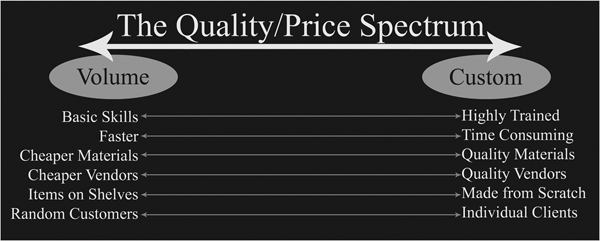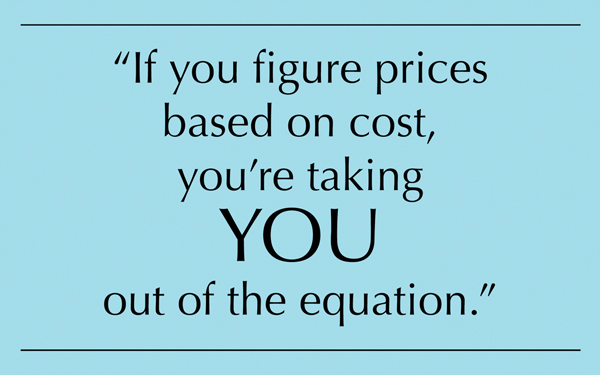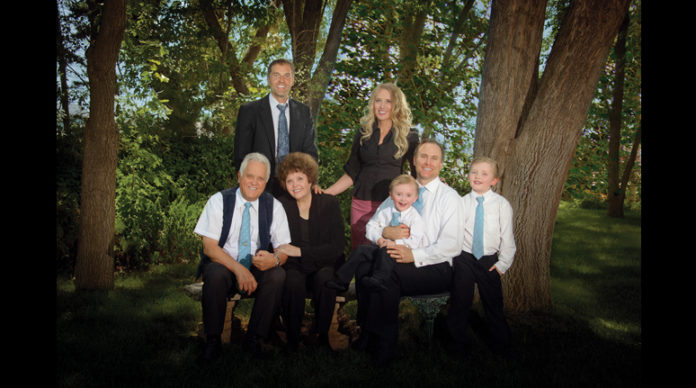By Bry Cox
Texas School Instructor
In a previous article, I talked about how proper pricing starts with valuing one image. From there you can expand out and set your prices for other options, sizes, and collections. For instance, don’t price an album based on what it costs you, but instead see it and price it as a collection of 20 original photographs. Let’s take that thought further because much of our inner concept of price and value comes from what we see and buy in our daily lives. We are constantly and subconsciously comparing our prices and value with everything else we see and pay for in stores everywhere. But how much of that is a true comparison? It’s actually a terrible comparison and like viewing our own prices with broken glasses. But with the right set of glasses, we can see clearly and help our clients also see and understand the difference clearly too.
Quality/Price Spectrum – At the core of our business strategy and ability to make comparisons with everything else in the marketplace is seeing quality and price on a spectrum. Most everything we see for sale in the world is on the left side, Volume. But what we create is on the right side, Custom. This is why we can’t compare our prices with random things we commonly buy.
Think of items on the Volume end as being mass-produced, able to be sold to anyone, and sitting on a shelf waiting to be purchased. If you don’t buy it, it stays on the shelf and is sold to the next person. Custom portrait photography is the exact opposite. It consists of items created from scratch each time for each client. I don’t have ready-made portraits of families on a shelf, waiting for customers to come in and buy them. And I don’t have customers either.

As photographers, we have individual clients that we specifically create work for. So, in simple terms, Volume businesses have shelves of mass-produced items for random customers, where Custom businesses create products from scratch for individual clients. Therefore the price has to be different.
As a photographer, I take raw materials like light, electrons, completely blank canvas and paper, and with my personal skills I arrange and organize these in a new way to create a family portrait that never existed before. This new finished product has immense value where the raw materials alone didn’t.
And if I create a family portrait for Client-A and they don’t buy it for some reason, I can’t put that back on the shelf and sell it to Client-B. All that time, the resources, the opportunity costs, and everything else that went into making that portrait is gone. Because they’re custom products that are extremely personal, I have to start over each and every time for each client.
Similarly, if Client-A spends only the tiniest amount of money, I can’t recoup what I should have made. I can’t put my lost time and overhead costs back on a shelf to sell to my next client. These resources are gone and I must start over again with each client and each shoot.
Comparing Other High End Products – You can’t even compare your photography to other higher-end products. For instance, perhaps when talking price, your client says, “Your canvas is how much? I could get a new iPhone for that.” And that comment makes you think, “How can I charge $1000 for one portrait when a huge company like Apple is selling a sleek, miniature communicator and do-everything gadget for that price. I’m just a small business in comparison so my prices must be too expensive.”

But understanding this Quality/Price Spectrum however, we see that an iPhone, though amazing, is mass-produced, sitting on shelves for anyone to buy. It’s not custom made for you. That original custom-made phone is the prototype and it probably cost over $100,000. But once it’s mass produced, the final price is just a fraction of that.
Time – The next big key is to know how much time it takes to create one portrait for someone on average. Break a standard shoot down into smaller stages, and measure how much time does it takes in each stage – regardless of what is purchased. Here’s a basic list to get you started.
1. Market and advertise to get the client in.
2. Answer emails and phone calls from prospective clients that both do and don’t hire us. (Remember that the time and money spent on people that don’t hire are eventually paid for by the clients that do.)
3. Consultations and phone calls about clothing, locations, and price.
4. Preparing for the shoot, packing equipment, and renting extra gear if you need it.
5. Loading the vehicle, and driving to and from the photo shoot (if it’s on location).
6. The actual photo shoot time.
7. Driving home from the shoot, unloading gear, returning rentals.
8. Downloading and backing up your files.
9. Preliminary Lightroom work (import, flag and cull, fast and basic global adjustments, export proofs for sales appointment).
10. Meet with the client for a sales appointment and take order.
11. Retouching and digital artwork.
12. Size, digitally sign, and send order off to your lab.
13. Order in custom frames and other items.
14. Frame, compile all finished products, and package order.
15. Call your client.
16. Deliver order, hang items in home (or package and ship to out-of-town clients).
17. Follow up and send a “thank you” card or gift.
We already have 17 time-consuming steps for just one order. Making your own list will help you realize that there is much more time involved than most imagine. But what if I hire some things out? Does that change things? No. No matter what, these things are a part of your costs. Everything on the list must be paid for. Time is money, and everything must be covered and paid for by the sale whether you pay yourself or someone else to do them.
What About YOU? – When figuring your prices, there’s more than just time. There’s YOU. Your business placard probably has your name on it because it’s not a random camera people are hiring, it’s YOU – the skilled artist. YOU are the photographer with the vision. YOU are the one growing to continually be better with recurrent training, more education, going to Texas School, spending a week with an instructor, and investing in YOU.
YOU cannot be replaced. Your business is named after YOU, built around YOU, your skills, your vision, your abilities. And if you figure your prices based on what it costs and simply do a markup percentage on those costs, then you’re taking YOU out of the equation. Your business must pay YOU so that it’s worth having the business. There are things in life you need to pay for: your mortgage, that newer car, your little girl’s ballet lessons, groceries, upgraded cameras and lighting, insurance, building up your savings, and on and on.
Being a photographer is a skilled job, and YOU and your skills are the value in the business. It’s crucial to understand the value of YOU and what that goes into every single order. YOU are why your prices must be correct. Your technical and creative skills, your personality, your ability to see the world in a unique way, your ability to make people relax on camera and look wonderful, your ability to light people perfectly, your ability to finely retouch an image and create a gorgeous canvas wall print – all of these things and much more are the reasons your clients are paying YOU.
Service or Product? – Finally, most businesses offer either a service or a product. For instance, if someone mows my lawn, that’s a service. If I buy a new kitchen appliance, that’s a product. Photographers often see themselves as a product centered business because we deliver photographs. But actually we’re weird; we’re a mix of both, and not 50/50 either. It’s more like 80/20, with 80% being service and 20% being the final photographs. A quick look over your long list of stages and time involved in each custom shoot should help make that point. And the final product you deliver is not only worth it, but it will grow in value over time too.
Years later a $1000 iPhone will have depreciated and diminished in value to where it is not even worth selling and will be handed off to a child to play with and throw around. But years later, that family portrait will have immense value. As loved ones leave us and families change, the canvas wall print grows in value to where people will run into burning homes to save it. We should recognize that value we’ve created for our clients.
Come Train at Texas School – This is just one small piece in running a successful photography business. Come spend a week with me at Texas School where we have the time to really delve into these subjects deeper. Plus we’ll combine this knowledge with live shoots, lighting, emotion, and understanding social dynamics so that you leave creating the best images of your career. See you there.
 Bry Cox is a Gold Medalist out of 25,000 international photographers. He is on the Adobe Software Evangelist team and is a PPA Master/Craftsman about 11 times over. Bry owned a studio in Utah for over 21 years and has been teaching workshops for over a decade. To learn more about Bry Cox, go to: www.BryCox.com or TexasSchool.org.
Bry Cox is a Gold Medalist out of 25,000 international photographers. He is on the Adobe Software Evangelist team and is a PPA Master/Craftsman about 11 times over. Bry owned a studio in Utah for over 21 years and has been teaching workshops for over a decade. To learn more about Bry Cox, go to: www.BryCox.com or TexasSchool.org.











